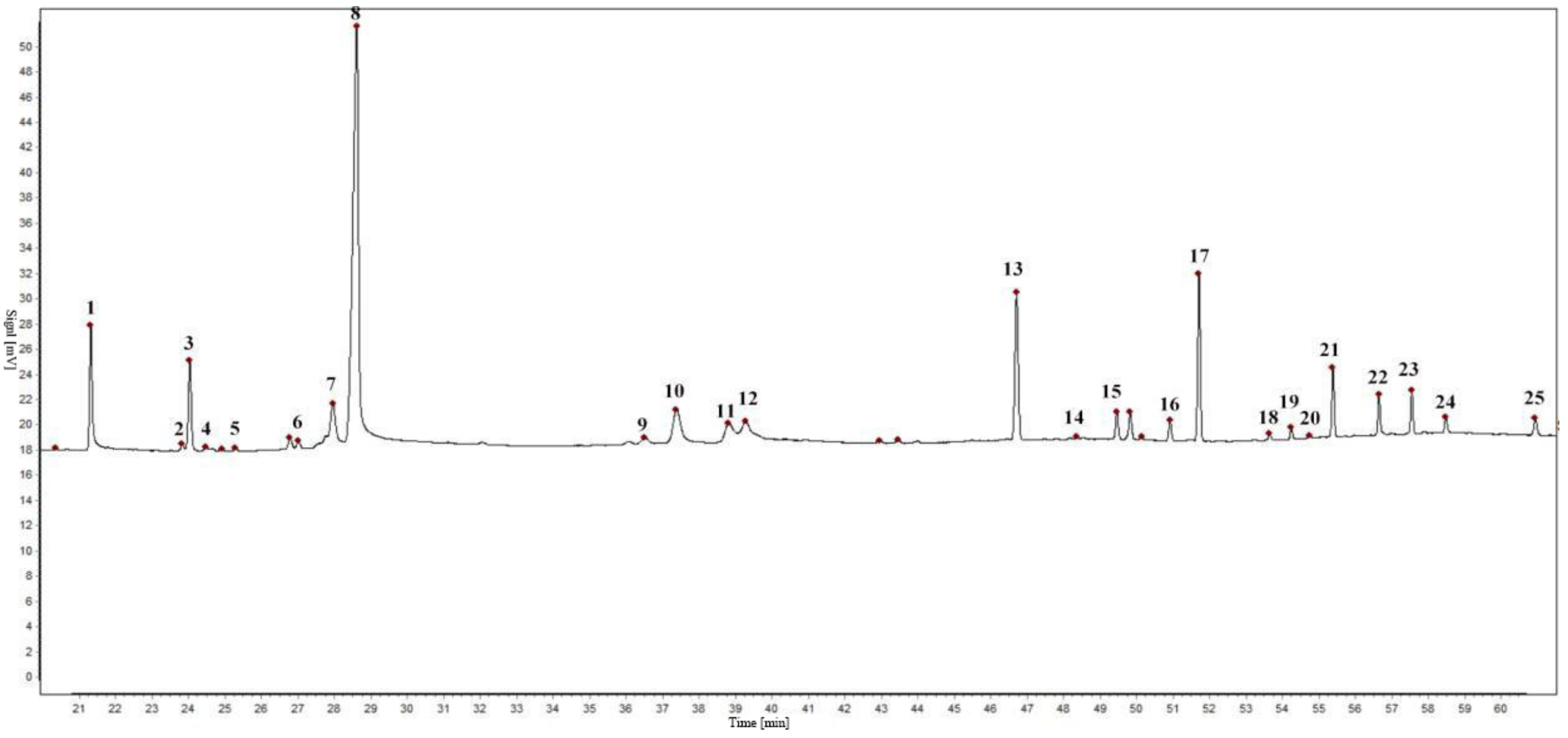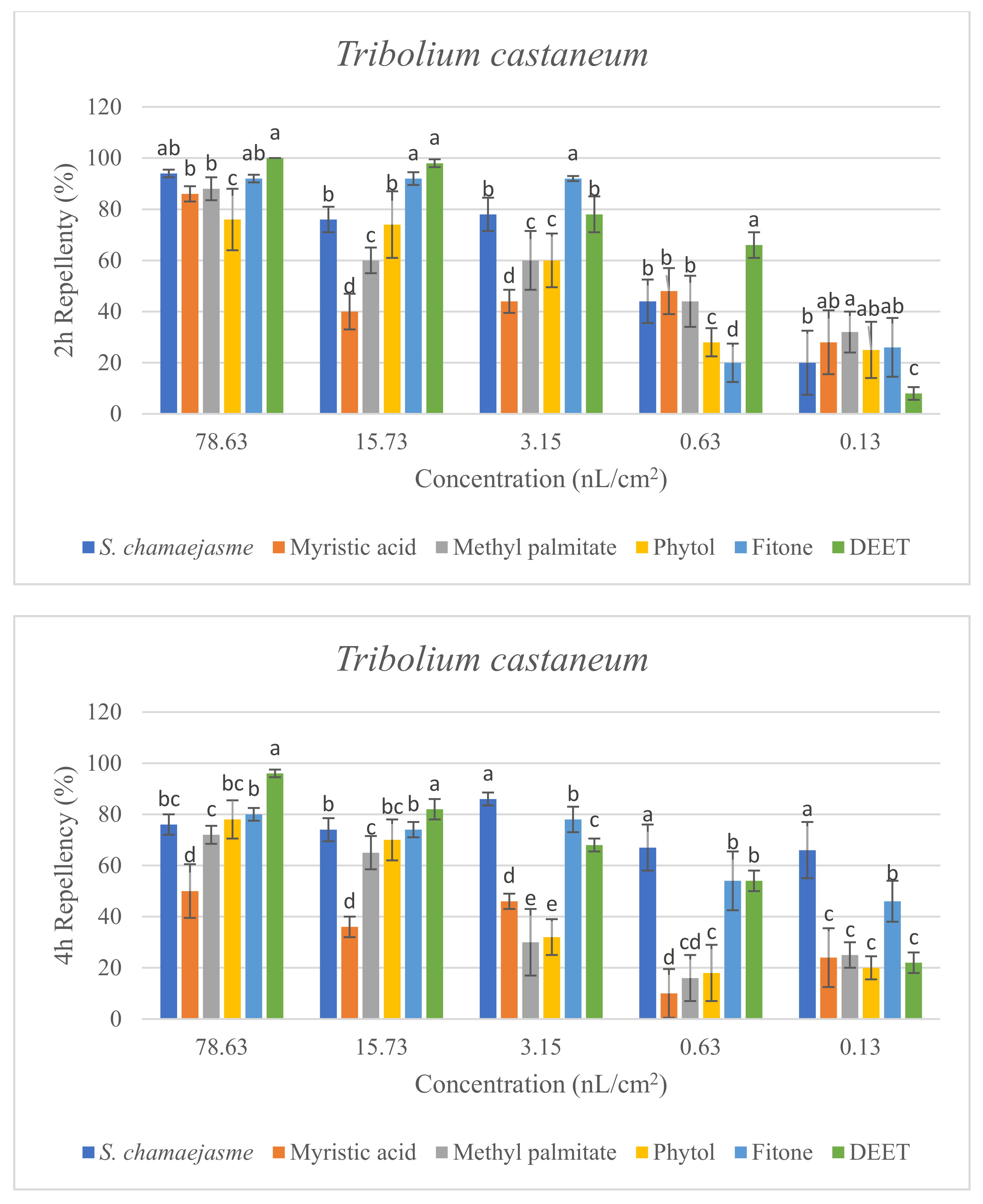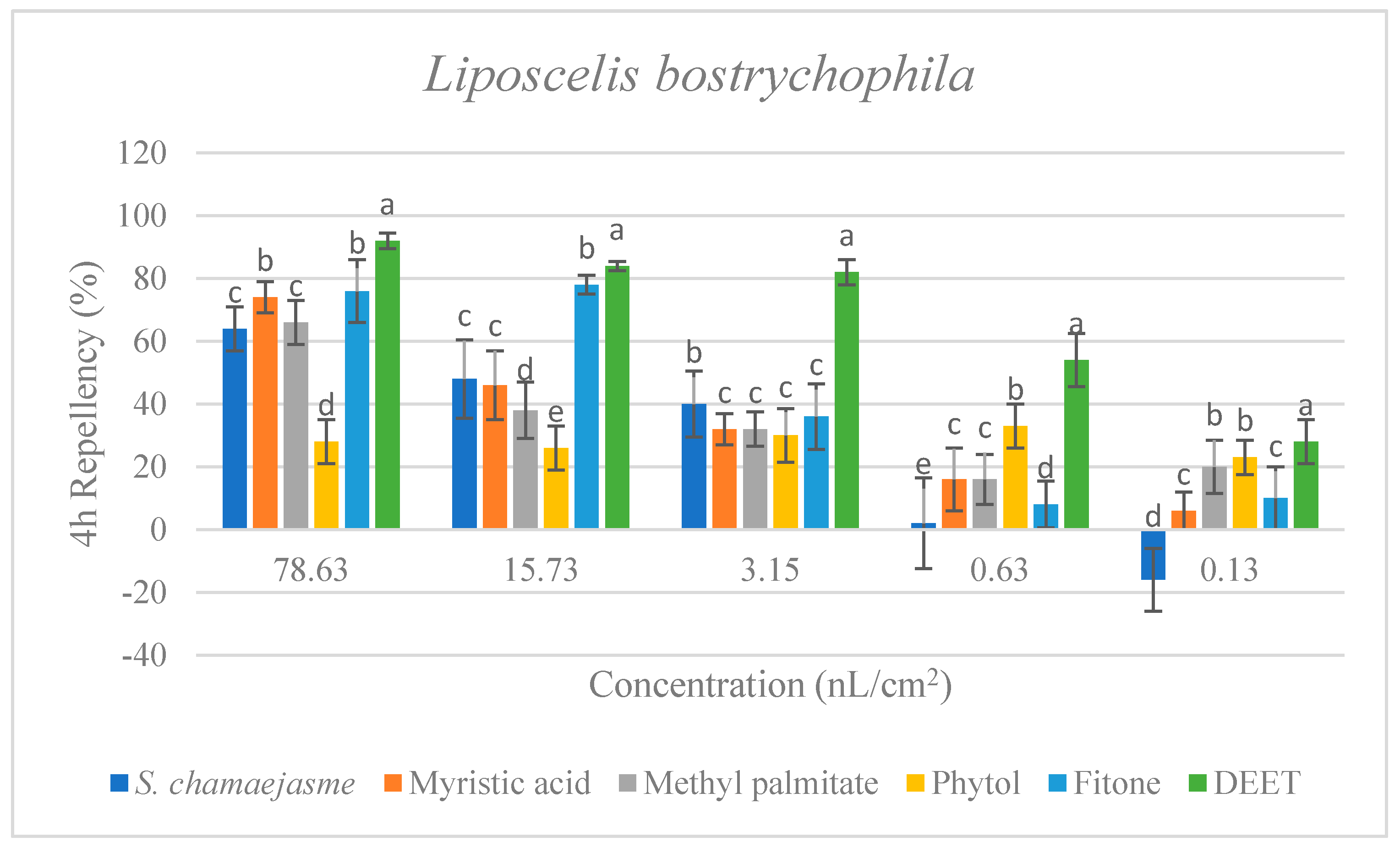1. Introduction
Stellera chamaejasme (L.) is a perennial herb of the genus
Stellera in the
Thymelaeaceae family. Its root is commonly used for removing phlegm, relieving pain, killing pests and for external use in the treatment of scabies in traditional Chinese medicine (TCM) [
1].
S. chamaejasme mainly grows on dry sunny hillsides, lawns, or riversides with an altitude range from 2600 to 4200 m above sea level, mean annual temperature of about 0 °C in the north and southwest of China, as well as in Siberian Russia. Previous studies have found that the root parts of
S. chamaejasme contain flavonoids, lignans, coumarins, terpenes and other chemicals [
2,
3], among which coumarins are its characteristic chemical components such as daphnetin, umbelliferone, edgeworthin, etc. However, there is relatively little research into the chemical composition of the flower part of
S. chamaejasme. Because
S. chamaejasme has strong survivability and expansion capacity on degraded grasslands, aggravating grassland desertification, it is generally considered as a grassland desertification indicator plant [
4,
5,
6]. In addition, studies showed the whole plant of
S. chamaejasme was toxic, as a result, poultry and livestock were often found to be poisoned in pastures by misusing
S. chamaejasme, which bring economic loss and a safety hazard to the urban resident and herdsmen [
7,
8].
Red flour beetle
Tribolium castaneum (Herbst) (Coleoptera: Tenebrionidae), cigarette beetle
Lasioderma serricorne (Fabricius) (Coleoptera: Anobiidae) and booklouse
Liposcelis bostrychophila (Badonnel) (Psocoptera: Liposcelididae) are worldwide and destructive pests of stored products, especially found in tropical and subtropical areas [
9,
10,
11]. Due to their strong adaption, rapid breeding ability and worldwide distribution, the above three insects have caused serious problems including agricultural economic loss, food contamination and health risks to consumers, etc. [
12,
13]. Therefore, pesticides such as synthetic insecticides have been widely used to control these stored product pests, in the meantime, overuse of synthetic chemical insecticides leads to environmental pollution, unexpected toxicity on the nontarget biosome and endangerment of human health [
14,
15]. Consequently, it is urgent to study new green and safe pesticides; natural plants have gained widespread interest in pest control on account of the insecticidal potential and easy degradation of their secondary metabolites [
16,
17,
18]. Nowadays, the development of botanical insecticides has been recognized as an efficient and environmentally acceptable alternative strategy for pest management.
Research has suggested that many plants possess insecticidal activities. For example,
Cinnamomum plants showed remarkable bioactivities against pests, and the EO of
C. zeylanicum was highly poisonous to some mosquito vectors and flies [
19]. The EO from roots and leaves of
Asarum heterotropoides also displayed toxicity and repellency against the cigarette beetle and booklouse [
20]. Additionally, some species of the
Rhododendron genus, such as
R. anthopogonoides,
R. thymifolium,
R. capitatum were all reported to have insecticidal properties, and the EO extracted from the species of
Rhododendron was utilized against stored product pests [
21]. According to the earliest Chinese pharmaceutical classics, the
Shennong herbal scripture, the whole plant of
S. chamaejasme is poisonous, and its pollen is a highly toxic part, which suggests the EO of
S. chamaejasme flowers could have the potential activity of a pesticide and the development of an insecticide may also provide an approach for the reasonable utilization of
S. chamaejasme plant resources [
22,
23,
24].
As is known, TCM has been widely used in the treatment of human diseases for a long time and has played an important role in clinical practice due to its therapeutic action, low toxicity and few side effects up to now. One characteristic of TCM products which is different from synthetic drugs is their complex and unstable chemical constituents, because the chemical composition of TCM products is always affected by many factors including the producing areas, harvest time, growth environment and field management [
25], resulting in a batch-to-batch variation to different degrees. In addition, the active components and the action mechanism of some TCM drugs are still unclear. Therefore, it is of great significance to establish the scientific quality control methods of TCM drugs based on their global chemical features, which could give support for identification, quality assessment and provide guidance for clinical medication. The combination of a chromatographic fingerprint and chemometrics analysis could be an effective way for the quality evaluation of TCM products, especially for judging the authenticity of TCM products by similarity evaluation [
26]. By analyzing the relative retention time and peak area or intensity ratio of the common peaks, the chemical profile and fingerprint of TCM drugs are established integrally and comprehensively. According to the chromatographic fingerprints, the similarities and differences of various TCM products can be intuitively compared. On the other hand, the chemometric method has become one of the popular modern analysis methods, because it can provide more information on the samples based on the chromatographic fingerprint. The correlation coefficient in chemometrics is the common index for evaluating the similarity of different samples, which can represent the difference and similarity between a set of chromatographic fingerprints and help to classify the quality traits by comparing it with the average reference values. Consequently, the systematic clustering analysis method has been widely used in the data analysis of chromatographic fingerprints, detecting the chromatographic fingerprint information more accurately and comprehensively [
27].
In this study, GC−MS was used to determine the chemical constituents of the EO from
S. chamaejasme flowers for the first time, and the gas chromatographic fingerprint combined with the chemometric method was successfully developed and applied to assess the quality consistency of seven batches of EOs from
S. chamaejasme flowers. By using the Chinese medicine chromatographic fingerprint similarity evaluation system (China National Pharmacopoeia Commission), the common characteristic peaks of
S. chamaejasme flowers EOs were confirmed and the similarities of
S. chamaejasme flowers from different areas were analyzed. In addition, the chromatographic fingerprint data of
S. chamaejasme flowers EO were systematically clustered to evaluate the consistency and differences of the samples. In the past, research on the
S. chamaejasme plant mainly focused on the chemical composition and pharmacological activities of the medical root part, while studies on the above-ground parts of this herb, particularly the research into the flowers of
S. chamaejasme were rarely reported [
28,
29]. In the light of the toxicity and the reported insecticidal effects of the root [
30,
31], our research team extracted the EOs of
S. chamaejasme flowers from various natural sites and evaluated their repellent activities against three worldwide pests (
T. castaneum,
L. serricorne, and
L. bostrychophila). Meanwhile, the repellent activities of the four main chemical compounds of the EO against these three pests were also measured. By analyzing the chromatographic fingerprints and repellent activities of the EO from
S. chamaejasme flowers, this study showed the similarities of seven batches of
S. chamaejasme and could also offer enlightenment for the development of botanical pesticides.
3. Experiment
3.1. Plant Materials and Extraction
The raw materials were collected from 7 wild-growing populations of
chamaejasme, identified in the region of Inner Mongolia (
Table 7), China. The flowers of
S. chamaejasme as experimental raw materials were used in this experiment. All medicinal herbs were identified as
Stellera chamaejasme plants in
Stellera genus of
Thymelaeaceae family by the Plant Resources Appraisal Office of the Inner Mongolia Autonomous Region Food and Drug Inspection Institute. All samples had been identified as shown in
Table 7. The fresh flowers of
S. chamaejasme were selected and air-dried at room temperature. The flowers were subjected to hydrodistillation for a period of 6 h in a Clevenger (São Paulo, SP, Brazil) apparatus to extract the essential oil by using steam distillation equipment. The yellow-green EO was finally obtained and stored in an airtight container at 4 °C in refrigerator.
3.2. Experimental Insects
The three species of insects (T. castaneum, L. serricorne, and L. bostrychophila) used in the experiment were sampled from laboratory reproduction and verified by Professor Z. L. Liu (College of Plant Protection, China Agricultural University, Beijing, China). These three insect species were cultivated in a constant temperature and humidity chamber with temperature controlled at 30 ± 1 °C and humidity maintained at 70–80%. The booklouse was raised in conical bottles (50 mL) containing a mixture of milk powder, yeast, and flour (1:1:10, w/w). The red flour beetle and the cigarette beetle were bred in glass containers (0.5 L) with a proportional mixture of yeast and flour (1:10, w/w). All insects used in this experiment were 1–2 weeks old.
3.3. GC-FID and GC−MS Analysis
GC instrument (Agilent 7890A/5975C, Santa Clara, CA, USA) equipped with flame ionization detector (FID) was used in this experiment to establish the chromatographic fingerprints of 7 batches of EOs of S. chamaejasme flowers from different natural sites. The chromatographic column was HP–5MS (30 m × 0.32 mm × 0.25 μm). Nitrogen gas was used as the carrier gas at flow rate of 1.0 mL/min and the volume injection was 3.0 μL of 0.4% solution (diluted in n-hexane). The following measurement procedure was finally adopted after screening. The starting temperature of the column was set at 80 °C for 4 min, firstly rising to 160 °C at a speed of 10 °C/min, then rising to 184 °C at a speed of 2 °C/min, rising to 186 °C at a speed of 0.2 °C/min for 5 min, lastly rising to 280 °C at a speed of 5 °C/min for 25 min. The temperature of 280 °C was determined as the final detection temperature and 82.8 min was the total time of the chromatographic fingerprints.
In order to determine the chemical composition of the EO from S. chamaejasme flowers, a GC instrument (Agilent 6890N, Wilmington, DE, USA) combined with a mass spectrometer (Bruker 320, Folsom, CA, USA) was used in this experiment. The capillary column was DB–5MS (30 m × 0.25 mm × 0.25 μm) and the standard mass spectra was NIST 05 (Standard Reference Data, Gaithersburg, MD, USA). The starting temperature was set as 50 °C for 5 min, then rising to 290 °C at the speed of 10 °C/min for 11 min. Forty minutes chromatography in total was recorded and the volume injected was 1 μL of 1% solution (diluted in n-hexane). Each of the EO’s chemical constituents’ relative percentages was calculated by averaging peak area reports.
3.4. Experimental Data Analysis Methods
The chemical composition of EO from S. chamaejasme flowers was determined by GC−MS, identified by computer mass spectrometry (NIST 05) standard spectrometry database, and checked by reference to relevant literatures and according to the law of mass spectrometry lysis. Chromatographic fingerprint data were valued by the ‘Similarity Valuation system of TCM chromatographic fingerprints’ (China National Pharmacopoeia Commission) to analyze the similarity of S. chamaejasme flowers in different natural sites. The common characteristic peaks of the chromatographic fingerprints of samples from different areas could be confirmed by this system.
3.5. Repellent Test
The four compounds, fitone, methyl palmitate, myristic acid and phytol, are the main components in the EO of
S. chamaejasme flowers, accounting for 52.764% of the total EO. Except phytol, the other three compounds are all terpenoids, a group of natural products usually possessing potential insecticidal activities. The repellent tests of EO from
S. chamaejasme flowers and the 4 compounds (fitone, methyl palmitate, myristic acid, and phytol) against red flour beetle and cigarette beetle were carried out in 9 cm diameter petri dishes, while the repellent tests for the booklouse were implemented in 5.5 cm diameter petri dishes [
48]. The EO and chemical compounds of
S. chamaejasme flowers were dissolved in
n-hexane to make a series of concentrations (78.63, 15.73, 3.15, 0.63, and 0.13 nL/cm
2) to test the repellent rate of the red flour beetle and the cigarette beetle [
49,
50,
51]. The specific experimental steps were to cut the filter paper with 9 cm diameter into two pieces on average. One half of paper was given 500 μL of
n-hexane solvent as a blank control and the other half was treated with testing medicine in same volume. Both pieces of paper were stuck to the bottom of the petri dish with a glue stick after drying in the air for 30 s. Twenty insects were placed in the center of petri dish and covered. As for the booklouse, the EO and compounds were dissolved in
n-hexane to prepare five different concentrations (63.17, 12.63, 2.53, 0.51, and 0.10 nL/cm
2) to test the repellent rate of the booklouse [
52,
53]. The specific methods were the same as above, but the difference was that the dose was 150 μL. The testing insects were kept in a constant temperature and humidity box with temperature of 29 °C ± 1 °C and relative humidity of 70−80% [
54,
55]. At 2 and 4 h, the number of insects present on both sides of paper in each petri dish was recorded. Each concentration test was repeated five times. Meanwhile, the commercial insect repellent
N,
N-diethyl-3-methylbenzamide (DEET) was used as positive control [
56,
57]. The formula for calculating the percent repellency (PR) was as follows:
Nc represented the number of insects in the control groups, and Nt represented the number of insects in the testing group. The average repellent rate and standard deviation values were evaluated using Tukey’s test and variance analysis (ANOVA) by SPSS 26.0 software (IBM SPSS, Armonk, NY, USA).












